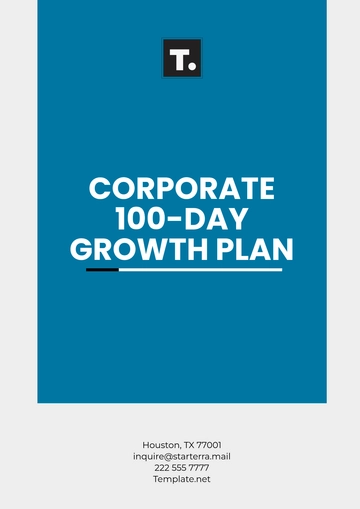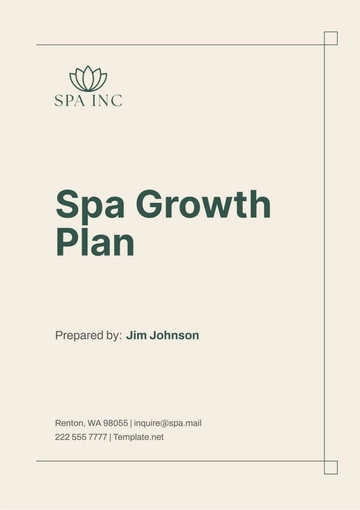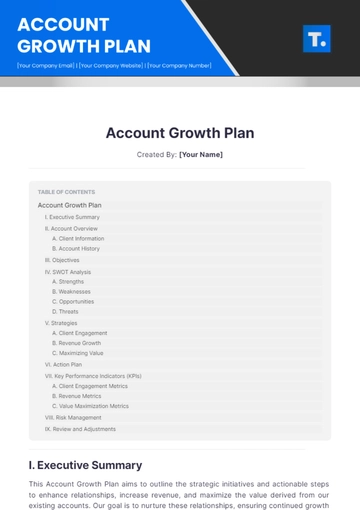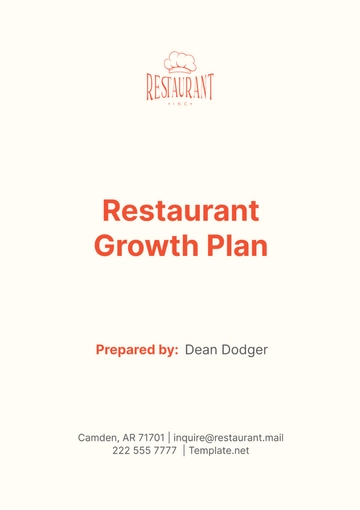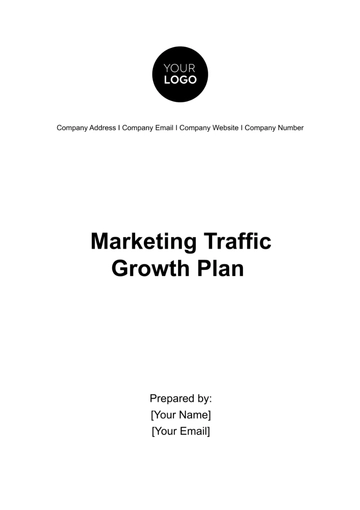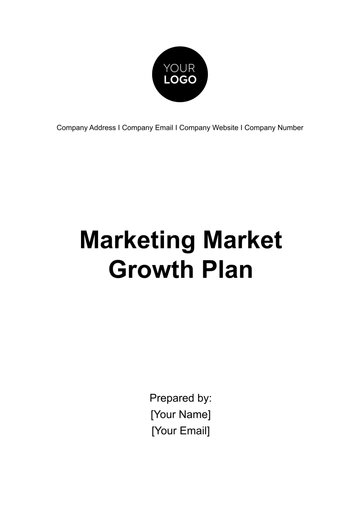Free Marketing Market Growth Plan
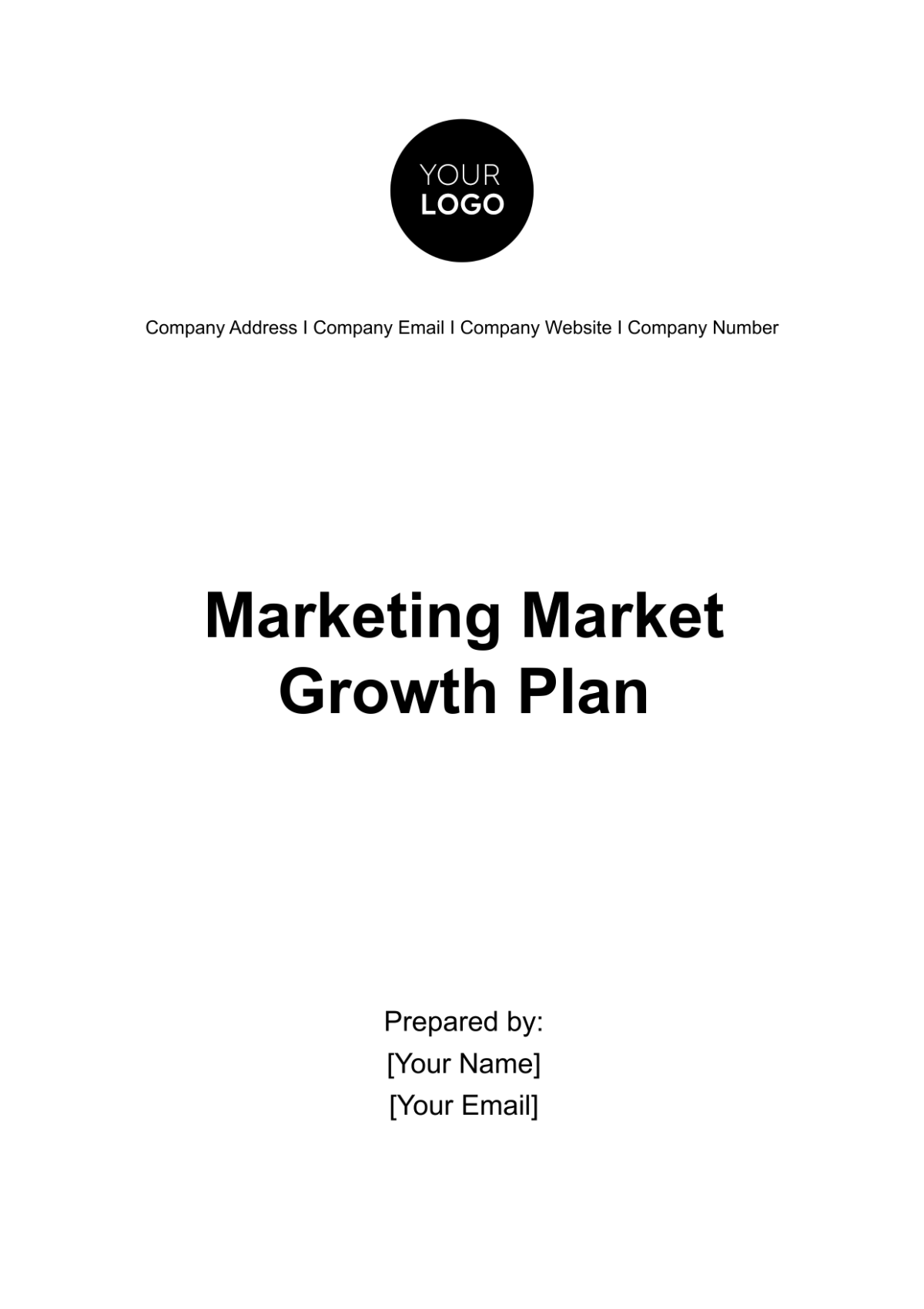
1. Executive Summary
Objective: Our primary objective with the [Your Company Name] Marketing Market Growth Plan is to achieve substantial growth within our target market. We aim to increase market share, enhance brand visibility, foster higher customer engagement, and ultimately boost revenue.
Expected Outcomes: By executing the strategies outlined in this plan, we anticipate achieving a 15% increase in market share over the next fiscal year. Additionally, we aim to grow our customer base by 20% and achieve a 25% revenue increase through the implementation of targeted marketing initiatives.
2. Company Information
Company Name: | [Your Company Name] |
Email Address: | [Your Company Email Address] |
Address: | [Your Company Address] |
Phone Number: | [Your Company Number] |
Website: | [Your Company Website] |
3. Introduction
Welcome to the [Your Company Name] Marketing Market Growth Plan. This comprehensive document outlines our strategic initiatives aimed at achieving significant growth within our target market.
In today's dynamic business landscape, having a well-defined growth strategy is paramount to maintaining and expanding our market presence. This plan reflects our commitment to growth, customer satisfaction, and long-term success.
Through thorough market analysis and the development of strategic objectives, we are confident that we can navigate market challenges, capitalize on opportunities, and achieve our growth targets.
4. Market Analysis
The Market Analysis section provides a detailed examination of the current market landscape, enabling us to make informed decisions based on market trends, competition, and opportunities.
Market Trends: Recent market trends in the California region indicate a growing preference for eco-friendly products and a shift toward online shopping. Consumers are increasingly valuing sustainability and convenience.
Competition: Our key competitors in the California market include "GreenSolutions Inc." and "EcoLux Enterprises." These companies have established a strong market presence through effective branding and extensive distribution networks. We will analyze their strengths to identify areas where we can differentiate ourselves.
Opportunities: Our analysis highlights opportunities in expanding into emerging markets within California, particularly in the urban areas of San Francisco and Los Angeles. Additionally, there is an untapped market segment of environmentally-conscious consumers seeking sustainable products, offering a prime growth opportunity.
By delving into these key aspects of the California market, we are well-equipped to formulate strategies that align with market dynamics and our growth objectives.
5. SWOT Analysis
A comprehensive SWOT (Strengths, Weaknesses, Opportunities, and Threats) analysis is a fundamental step in our market growth strategy. It enables us to gain a deeper understanding of our position within the California market.
Strengths: |
|
Weaknesses: |
|
Opportunities: |
|
Threats: |
|
This SWOT analysis serves as the foundation for our strategic decision-making, allowing us to leverage our strengths, address weaknesses, capitalize on opportunities, and mitigate threats effectively.
6. Target Audience Identification
Defining our target audience is a critical step in our growth plan. We aim to resonate with specific customer segments in California that align with our products and values.
Ideal Customer Segments:
Environmentally-Conscious Millennials: We will target environmentally conscious individuals aged 25-40 who prioritize sustainability and seek eco-friendly products.
Urban Professionals: California's urban centers, such as San Francisco and Los Angeles, provide opportunities to engage with professionals looking for convenient and sustainable solutions.
Corporate Partners: Collaborating with local businesses and corporations to promote sustainable practices and provide eco-friendly products for their employees.
Understanding and connecting with these segments will be pivotal in tailoring our marketing efforts and product development to meet their needs and preferences.
7. Marketing Objectives
Our Marketing Objectives are specific, measurable, and time-bound goals designed to drive our market growth strategy. The following objectives outline our key performance targets:
Objective 1: Increase Market Share
Target: Achieve a 15% increase in California market share within the next 12 months.
Strategy: Launch targeted marketing campaigns and promotional activities to increase brand visibility and customer acquisition.
Objective 2: Expand Customer Base
Target: Grow our customer base by 20% in the next fiscal year.
Strategy: Develop customer engagement programs and loyalty initiatives to attract new customers and retain existing ones.
Objective 3: Boost Revenue
Target: Achieve a 25% increase in revenue in the next 18 months.
Strategy: Implement a tiered pricing strategy, introduce new product offerings, and optimize distribution channels for enhanced sales.
8. Marketing Strategies
Our Marketing Strategies outline the high-level approaches and tactics we will employ to achieve our objectives, ensuring alignment with our growth plan.
Product Development:
Introduce a new line of sustainable and innovative products tailored to the preferences of the California market.
Continuously improve existing products based on customer feedback and market trends.
Pricing Strategy:
Implement dynamic pricing to optimize profitability while remaining competitive in the California market.
Offer discounts and promotions during key sales seasons to attract price-sensitive customers.
Distribution Channels:
Expand our e-commerce platform to reach a broader customer base across California.
Explore partnerships with local retailers to increase our physical presence.
Promotion Tactics:
Launch a comprehensive digital marketing campaign, targeting social media platforms frequented by our key demographics.
Engage in eco-friendly initiatives and collaborations to enhance brand image and credibility.
By implementing these strategies, we aim to achieve our marketing objectives and drive significant growth within the California market.
9. Marketing Mix (4Ps or 7Ps)
Our Marketing Mix encompasses the fundamental elements that shape our marketing strategy and help us deliver value to our customers in the California market.
Product:
Our product portfolio comprises innovative, sustainable, and environmentally friendly solutions. Examples include "EcoClean Household Cleaners," "GreenTech Solar Chargers," and "PureEco Organic Cotton Bedding." These offerings align with the preferences of eco-conscious consumers.
Price:
Our pricing strategy is designed to strike a balance between profitability and affordability. We offer competitive prices that reflect the value of our products. Additionally, we employ dynamic pricing strategies to optimize revenue based on market demand.
Place (Distribution):
To ensure easy accessibility for our customers, we employ a multi-channel distribution approach. Our products are available both online through our e-commerce platform and in select retail locations across California, including "EcoMart" and "GreenLife Stores."
Promotion:
Our promotional efforts are designed to create awareness and drive engagement. Key strategies include:
Digital Marketing: Leveraging social media advertising, email marketing, and online content to reach our target audience.
Sustainability Initiatives: Engaging in eco-friendly campaigns and partnerships to enhance our brand's image as a socially responsible entity.
Influencer Collaborations: Partnering with environmental influencers and thought leaders to increase brand credibility.
People, Processes, Physical Evidence (Optional):
People: Our dedicated team of professionals is committed to providing excellent customer service and product support.
Processes: We continuously refine our production processes to ensure the highest quality and sustainability standards.
Physical Evidence: Our eco-friendly packaging and product labeling reflect our commitment to sustainability, enhancing the overall customer experience.
10. Budget and Resource Allocation
Effective allocation of financial and human resources is crucial to the successful execution of our Marketing Market Growth Plan.
Marketing Budget: Our total marketing budget for the upcoming year is $2,500,000. This budget encompasses all marketing activities, including advertising, promotions, and research.
Resource Allocation: We have allocated resources to various departments to execute the plan effectively:
Resource Team | Budget Amount | Details |
Marketing Team: | $1,200,000 | Responsible for campaign planning, content creation, and digital marketing efforts. |
Product Development: | $500,000 | Funding product research and development to enhance our product portfolio. |
Sales Team: | $400,000 | Focused on expanding our distribution channels and building relationships with retailers. |
Customer Support: | $200,000 | Ensuring exceptional customer service and support for existing and potential customers. |
Research and Analytics: | $200,000 | Gathering market insights and analyzing data to inform strategy adjustments. |
This resource allocation ensures that each department has the necessary resources to contribute to our growth objectives effectively.
11. Action Plan
Our Action Plan provides a detailed timeline of tasks, responsibilities, and key milestones to guide the execution of our marketing strategies.
Month | Tasks | Responsible Team Member |
January | Market Research, Product Development | John Smith, Sarah Johnson |
February | Digital Marketing Campaign Launch, Retailer Collaboration | Emily Brown, David Clark |
March | Social Media Influencer Partnerships, Sales Team Expansion | Sophia Lee, Michael Evans |
April | Content Creation for Online Campaign, Inventory Management Optimization | Emily Brown, Sarah Johnson |
May | E-commerce Website Redesign, Sustainability Webinars and Workshops | David Clark, Sophia Lee |
June | Influencer Marketing Campaign, New Product Launch | Emily Brown, Sarah Johnson |
July | Customer Feedback Analysis and Implementation, Sales Training and Development | Michael Evans, David Clark |
August | Email Marketing Campaign, Sustainability Partnership Negotiations | Emily Brown, Sophia Lee |
September | Market Performance Review and Strategy Adjustment, Production Efficiency Enhancement | ohn Smith, Sarah Johnson |
October | Holiday Season Marketing Planning, Retailer Relationship Building | Emily Brown, David Clark |
November | Year-End Marketing Campaign, Sustainability Reporting and Impact Assessment | Michael Evans, Sophia Lee |
December | Annual Performance Review and Future Planning, Budget Allocation for the Next Year | John Smith, Sarah Johnson |
12. Metrics and KPIs
To gauge the effectiveness of our Marketing Market Growth Plan, we have defined key performance indicators (KPIs) that align with our objectives:
Conversion Rate: Our target conversion rate is set at 10%. We aim to convert website visitors into customers through strategic marketing initiatives.
Customer Acquisition Cost: We aim to maintain a target customer acquisition cost of $50 per new customer. This cost includes marketing expenses, advertising, and promotional activities.
Revenue Growth: Our goal is to achieve a 25% increase in revenue over the next 18 months. This metric will reflect the overall success of our growth plan.
These KPIs will serve as critical benchmarks for evaluating our progress and making data-driven adjustments to our strategies.
13. Risk Analysis
Identifying potential risks and obstacles is essential for proactive planning. We have outlined several key risks and corresponding mitigation strategies:
Market Saturation: With intense competition, there is a risk of market saturation. To mitigate this, we will continually innovate our product line and seek new market segments.
Regulatory Changes: California's evolving environmental regulations may impact our product development. We will closely monitor and adapt to regulatory changes promptly.
Economic Downturn: Economic fluctuations can affect consumer spending. In response, we will maintain a diversified product portfolio and adjust marketing efforts based on economic trends.
Supply Chain Disruptions: Potential supply chain disruptions may occur due to global factors. To mitigate this, we will maintain strong relationships with suppliers and have contingency plans in place.
Digital Security: As we expand our digital presence, cybersecurity risks may arise. We will invest in robust cybersecurity measures to protect customer data and online assets.
By proactively addressing these risks, we aim to minimize their impact on our plan's execution.
14. Monitoring and Reporting
Our process for monitoring and reporting plan progress involves a systematic approach:
Regular Data Analysis: We will conduct regular data analysis of our KPIs, tracking conversion rates, customer acquisition costs, and revenue growth on a monthly basis.
Monthly Progress Meetings: Cross-functional teams will meet monthly to review data, assess performance against objectives, and discuss necessary adjustments.
Quarterly Strategy Review: Every quarter, we will conduct a comprehensive review of our marketing strategies, considering market trends and feedback from customers and stakeholders.
Stakeholder Reporting: We will provide quarterly reports to key stakeholders, including executives, board members, and investors, outlining our progress and any strategic adjustments.
This iterative process of monitoring and reporting will ensure that we remain agile and responsive to changes in the market and our performance.
15. Conclusion and Summary
In conclusion, the [Your Company Name] Marketing Market Growth Plan is a strategic roadmap designed to propel us toward significant growth within the California market. Our objectives are clear: increase market share, expand our customer base, and boost revenue.
Throughout this plan, we have outlined the critical components, from market analysis and SWOT assessment to defining our target audience and setting measurable KPIs. Our strategies encompass product innovation, competitive pricing, multi-channel distribution, and impactful promotions.
As we execute this plan, we are mindful of potential risks and have established mitigation strategies to address them promptly. Regular monitoring and reporting will keep us on track and enable us to adapt to evolving market dynamics.
In summary, the success of our plan hinges on our ability to remain agile, customer-focused, and environmentally conscious. By aligning our objectives with the needs of the California market, we are well-positioned for sustainable growth and a prominent role in the region's eco-friendly marketplace.
- 100% Customizable, free editor
- Access 1 Million+ Templates, photo’s & graphics
- Download or share as a template
- Click and replace photos, graphics, text, backgrounds
- Resize, crop, AI write & more
- Access advanced editor
Explore the Marketing Market Growth Plan Template by Template.net, an editable and customizable solution for crafting robust strategies. Tailor your growth plans effortlessly with its user-friendly interface. Seamlessly edit using our Ai Editor Tool, empowering you to drive market expansion with precision and efficiency. Unleash your potential today.
You may also like
- Finance Plan
- Construction Plan
- Sales Plan
- Development Plan
- Career Plan
- Budget Plan
- HR Plan
- Education Plan
- Transition Plan
- Work Plan
- Training Plan
- Communication Plan
- Operation Plan
- Health And Safety Plan
- Strategy Plan
- Professional Development Plan
- Advertising Plan
- Risk Management Plan
- Restaurant Plan
- School Plan
- Nursing Home Patient Care Plan
- Nursing Care Plan
- Plan Event
- Startup Plan
- Social Media Plan
- Staffing Plan
- Annual Plan
- Content Plan
- Payment Plan
- Implementation Plan
- Hotel Plan
- Workout Plan
- Accounting Plan
- Campaign Plan
- Essay Plan
- 30 60 90 Day Plan
- Research Plan
- Recruitment Plan
- 90 Day Plan
- Quarterly Plan
- Emergency Plan
- 5 Year Plan
- Gym Plan
- Personal Plan
- IT and Software Plan
- Treatment Plan
- Real Estate Plan
- Law Firm Plan
- Healthcare Plan
- Improvement Plan
- Media Plan
- 5 Year Business Plan
- Learning Plan
- Marketing Campaign Plan
- Travel Agency Plan
- Cleaning Services Plan
- Interior Design Plan
- Performance Plan
- PR Plan
- Birth Plan
- Life Plan
- SEO Plan
- Disaster Recovery Plan
- Continuity Plan
- Launch Plan
- Legal Plan
- Behavior Plan
- Performance Improvement Plan
- Salon Plan
- Security Plan
- Security Management Plan
- Employee Development Plan
- Quality Plan
- Service Improvement Plan
- Growth Plan
- Incident Response Plan
- Basketball Plan
- Emergency Action Plan
- Product Launch Plan
- Spa Plan
- Employee Training Plan
- Data Analysis Plan
- Employee Action Plan
- Territory Plan
- Audit Plan
- Classroom Plan
- Activity Plan
- Parenting Plan
- Care Plan
- Project Execution Plan
- Exercise Plan
- Internship Plan
- Software Development Plan
- Continuous Improvement Plan
- Leave Plan
- 90 Day Sales Plan
- Advertising Agency Plan
- Employee Transition Plan
- Smart Action Plan
- Workplace Safety Plan
- Behavior Change Plan
- Contingency Plan
- Continuity of Operations Plan
- Health Plan
- Quality Control Plan
- Self Plan
- Sports Development Plan
- Change Management Plan
- Ecommerce Plan
- Personal Financial Plan
- Process Improvement Plan
- 30-60-90 Day Sales Plan
- Crisis Management Plan
- Engagement Plan
- Execution Plan
- Pandemic Plan
- Quality Assurance Plan
- Service Continuity Plan
- Agile Project Plan
- Fundraising Plan
- Job Transition Plan
- Asset Maintenance Plan
- Maintenance Plan
- Software Test Plan
- Staff Training and Development Plan
- 3 Year Plan
- Brand Activation Plan
- Release Plan
- Resource Plan
- Risk Mitigation Plan
- Teacher Plan
- 30 60 90 Day Plan for New Manager
- Food Safety Plan
- Food Truck Plan
- Hiring Plan
- Quality Management Plan
- Wellness Plan
- Behavior Intervention Plan
- Bonus Plan
- Investment Plan
- Maternity Leave Plan
- Pandemic Response Plan
- Succession Planning
- Coaching Plan
- Configuration Management Plan
- Remote Work Plan
- Self Care Plan
- Teaching Plan
- 100-Day Plan
- HACCP Plan
- Student Plan
- Sustainability Plan
- 30 60 90 Day Plan for Interview
- Access Plan
- Site Specific Safety Plan
